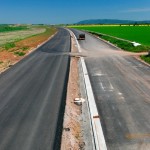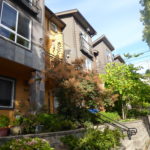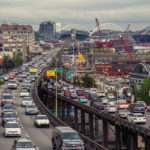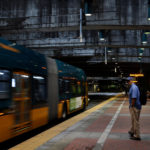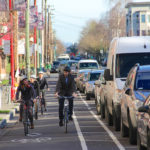Search Results
-
Sightline Does the Math on the Seattle Viaduct
Sightline research director Clark Williams-Derry analyzes the Seattle viaduct debate and comes to a few simple conclusions: roads are expensive, rush hour is the worst problem, and the differences between short- and long-term consequences.Read more » -
A Better Way to Replace Viaduct?
A draft of a paper (MSWord link, 4.6 M) just crossed my desk, and I thought it deserved a bit of visibility. It’s by Tom Byers of the Cedar River Group, who’s got a smart, homespun way of thinking about the recent controversy surrounding Seattle’s Alaskan Way Viaduct: When I was a kid, my grandfather used to tell me, by way of giving me the wits to find my way...Read more » -
Imagine There’s No Viaduct
I thought this was interesting. Here are some visual concepts for what Seattle’s waterfront might look like sans Alaska Way Viaduct, presented yesterday by University of Washington students in the urban design and planning program. One of the more unusual ideas: a series of large greenhouses that would step down from Victor Steinbrueck Park to the aquarium. (Davila Parker-Garcia) I have no idea if greenhouses would pencil...Read more » -
Clogged Viaduct
I haven’t written much recently about one of my pet obsessions, Seattle’s Alaskan Way Viaduct—perhaps because there hasn’t really been much to mention. Now there is. From what I hear, the Seattle city council is considering putting an advisory vote on the Viaduct on this November’s ballot. Voters would only get to choose one of two options: rebuilding the highway along Seattle’s waterfront pretty much as it is now, or...Read more » -
Dead End For Viaduct?
(This post is part of a series.) Headline from the Seattle Times: Remove the viaduct even if state can’t rebuild it? Apparently, Seattle city officials are increasingly willing to say that, if the state’s gas tax hike is repealed this November (as looks increasingly likely), the Alaskan Way Viaduct along Seattle’s downtown waterfront should simply be torn down. The existing structure poses a safety hazard, and without the $2 billion...Read more » -
The Role of Community Land Trusts in Cascadia’s Quest for Affordable Housing
-
Viadoom Avoided?
Trafficopalypse. The Big Clog. Carmageddon. And now Viadoom. It seems like the same story every time. Transportation planners announce the impending closure of urban highway lanes. Pundits and tongue-waggers confidently predict a terrifying hell-scape of congestion. But as soon as the lanes actually close, travelers quickly adjust, and the anticipated gridlock never materializes. It happened in Seattle just over a decade ago, when WSDOT closed two lanes of Interstate 5...Read more » -
Uber and Lyft Don’t Have to Threaten Transit. They Could Make It Better.
In less than two months, Cascadia’s largest city, Seattle, will close its Alaskan Way Viaduct once and for all. During the weeks it takes crews to connect its replacement deep bore tunnel, the city’s downtown traffic will endure a “period of maximum constraint.” Congestion could get nightmarish. The Period of Maximum Constraint is also a golden opportunity. It’s a chance to demonstrate that a marriage between transit and ride-hailing services...Read more » -
Of Cascadia’s Big Cities, Who’s Tops in Bikeways?
It only takes a few minutes talking to transport honchos in Portland, Seattle, and Vancouver, BC, to get a sense of the intense, if friendly, competition among their cities to be king of the cycling hill. But in many ways the three largest urban centers of Cascadia form one big, soggy petri dish of experimentation in bike infrastructure. All three are North American leaders in prioritizing complete streets and bicycle...Read more » -
To Build 1,764 New Homes This Year, Seattle Demolished… Just 21
The story is deeply embedded in popular perceptions of the modern city: modest, low-cost apartments succumb to the wrecking ball to make way for ritzy highrises, putting working-class residents out on the street. The displacement caused by demolitions of low-cost housing can be devastating to poorer families and their communities, and urban advocates and policymakers widely agree that minimizing displacement is a critical public policy goal. In the case of...Read more »

